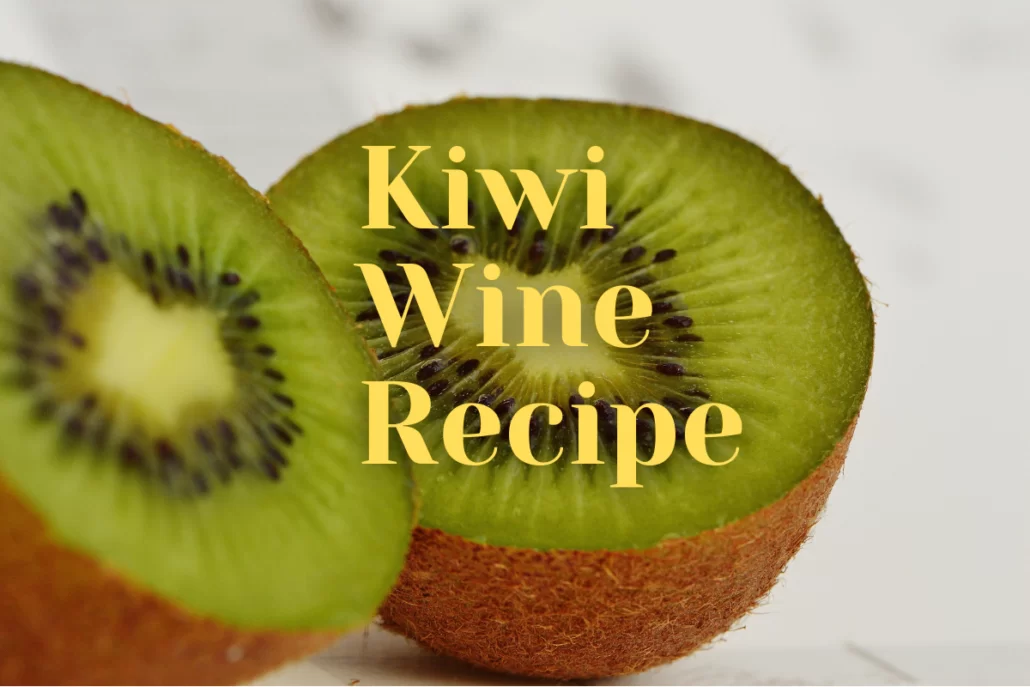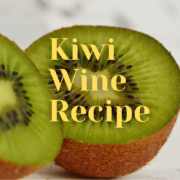Kiwi Wine Recipe – Fruity, Tropical White Wine

Kiwi fruit is surprisingly inexpensive and they are available year-round so they make a great fruit wine when everything else is out of season.
Kiwi wine is never going to be as popular as something like strawberry wine but in terms of the level of flavour both are around the same. Kiwi fruit also has the distinct advantage of being in supermarkets in the depths of winter. Kiwi fruit is grown in multiple regions and ripen well after being picked so they are available year-round in most places.
Kiwi wine makes a nice crisp white wine (with a tinge of green) and has an almost tropical flavour with melon and tart berries. You can make kiwi wine in the winter and it will be perfect for when the summer comes around to enjoy sitting outside in the sun.
Table of Contents
Sourcing The Best Kiwi Fruit For Making Wine
Kiwi tends to be relatively cheap at most grocers and supermarkets. This is often because they need to be ripened at home. This is not a problem but does mean a bit of planning is required to make this wine.
We need to use the ripest kiwi fruit we can get, this means the stage just before they get mushy.
If you are buying hard, unripe kiwi to ripen at home then you can let them get to just the point when they are at their ripest and then peel them and freeze them. Freezing them will prevent them from spoiling and mean you can put the fruit aside as and when they are at their ripest.
Of course, you don’t have to freeze them but it means you can manage a lot of kiwi fruit ripening at different rates and collect them ready to make the kiwi wine without any fruit spoiling.
Get Creative With Kiwi Wine
Kiwi fruit make a great partner to many other fruits and flavours. It is worth experimenting with some combinations to make a truly unique wine.
Kiwi and strawberries work really well together and the combination seems to boost the strawberry flavour as well as bringing a fruity quality.
You could also try pairing kiwi with some bolder flavours like ginger or tropical fruit like pineapple that makes a terrifically flavourful wine when most other fruit is out of season.
Kiwi also works well in floral wines, providing some crispness and acidity in what can otherwise be a floral wine that lacks body and bite.
Take the kiwi wine recipe below and try swapping some of the kiwis with other fruit or add some other flavours to create something really unique.
Kiwi Wine Recipe
What You’ll Need To Make Kiwi Wine – Makes 1 gallon / 4.5 litres
- Large Stock Pot
- Small Fermenting Bucket
- Demijohn
- Syphon
- Fine Straining Bag
- Potato Masher
- Airlock & Bung
Kiwi Wine Ingredients
- 1.5kg Kiwi Fruit
- 4 litres Water
- 1kg White sugar
- 1/8 tsp Wine Tannin
- 1tsp Mixed Acid
- 1/2 tsp Pectic Enzyme
- 1 tsp Yeast Nutrient
- 1 Campden Tablet
- 1 Sachet White Wine Yeast (Lalvin D47 is a good choice)
In a large heavy-bottomed pan add the sugar with half of the water. Heat and stir to dissolve and bring to a simmer.
Whilst the sugar solution is heating, prepare the kiwi fruit. Peel and cut the kiwi into chunks and place the fruit in the straining bag tucked into the sanitised fermenting vessel. Mash the fruit roughly to break it up with the potato masher.
Once mashed make sure the bag is secured around the top of the fermenter and then add the boiling sugar solution. Allow it to sit a few moments before adding the rest of the water which will bring the temperature down.
Add the mixed acid, tannin and yeast nutrient, mix well with a sanitised spoon and then cover and allow to cool completely.
Once cool add the Campden tablet and then cover with the lid and airlock and allow to sit for at least 12 hours. After 12 hours add the pectic enzyme and allow it to sit for another 12 hours. Take a hydrometer reading here to get your starting gravity for the wine.
After 24 hours add the yeast by sprinkling it onto the surface of the must without stirring, cover the fermenter with the lid and airlock and allow fermentation to start in around 24 – 72 hours.
Stir the kiwi wine daily with a sanitised spoon to prevent the fruit from drying on the surface while fermentation is in progress. After 7 days lift the bag out and allow it to drain without squeezing the bag. The kiwi can now be discarded.
Let the wine finish fermentation and start to settle for 2 or 3 days and then rack the wine into a demijohn/carboy. Insert a bung and airlock and let the wine finish fermentation and conditioning in the demijohn. As sediment builds up and the wine clears rack the wine into a clean demijohn/carboy and wait for the wine to clear completely.
The kiwi wine will benefit from ageing in the demijohn for a few months before being bottled. Once the wine is completely clear and has sat for 3 – 4 months you can proceed to bottle.
Once bottled set aside for as long as you can bear before trying, it is good to leave a least a few months before enjoying the wine and by that time you will notice great improvements in terms of flavour and body.




Leave a Reply
Want to join the discussion?Feel free to contribute!